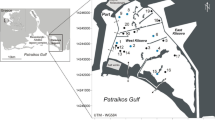Abstract
Since Delaware's coastal bays have been highly eutrophied for at least twenty years and Maryland's coastal bays are not nutrient stressed, dominance of the fish community in Delaware's coastal bays by Fundulus sp. may be an indicator of nutrient stress. Maryland's coastal bays are menhaden, spot, and anchovy dominated. The dominance of Fundulus sp. in a nutrient-stressed system relates to the hardy nature of these fishes, especially in low-oxygen conditions. Submerged aquatic vegetation as seagrasses (SAV) has been absent from the highly nutrient-stressed Delaware coastal bays for about twenty-five years. In contrast, SAV is still found in Maryland's coastal bays. The loss of SAV as a habitat for young fish may also be contributing to the apparent species shift in Delaware's coastal bays.
Indian River Bay is less hospitable to macroalgae (seaweeds) than Rehoboth Bay. Dominance of Ulva in Indian River Bay reflects its tolerance to varying salinities, higher nutrient levels, and increased turbidities, and indicates a stressed system. The total volume of macroalgae, especially in Rehoboth Bay, tends to follow the seasonal cycle for phosphorus.
Based on an assessment of the ecological condition of the Delaware and Maryland coastal bays conducted by EMAP in 1993 and other related studies, the author offers a conceptual framework for Delaware's inland bays environmental classification, considering the water quality parameters of turbidity, TSS, Chla, DIN, DIP, and O2 as they relate to presence of SAV, seaweed abundance and diversity, benthic invertebrate diversity, and fish sensitivity to low oxygen.
Similar content being viewed by others
References
Andres, A.S. 1992. Delaware Geological Survey Open File Report #35, 36 pages.
Bigelow, H.B., and W.C. Schroeder.: 1953. Fish Bull. Of Fish and Wildlife Ser., 53:577 pages.
Bolen, C. and W. Boynton. 1997. Report to Maryland Coastal Bays Program. University of Maryland 71 pages.
Cerco, C.F., B. Bunch, M.A. Cialone, and H. Wang.: 1994. U.S. Army Corps of Engineers, Technical Report EL-94-5. 246 pages.
Daiber, F.C., and multiple authors: 1976. An Atlas of Delaware's Wetlands and Estuarine Resources. Office of Coastal Zone Management. Technical Report 2 Dover, Delaware 530 pages.
Dennison, W.C., R.J. Orth, K.A. Moore, J.C. Stevenson, V. Carter, S. Kollar, P.W. Bergstrom, and R. Batiuk.: 1993. Bioscience 43:86–94.
Derickson, W.K., and K.S. Price.: 1973. Trans. Amer. Fish. Soc. 102(3):552–562.
deSylva, D.P., F.A. Kalber, Jr., and C.N. Schuster.: 1962. University of Delaware, Marine Laboratory, Information Series, Publ. No. 5, 164 pages.
Environmental Protection Agency.: 1996. EMAP EPA/620/R-96/004. 78 pages.
Grecay, P.A.: 1990. Ph.D. Dissertation, University of Delaware. Newark, Delaware. 179 pages.
Hinga, K.R., H. Jeon, and N.F. Lewis.: 1995. NOAA Coastal Ocean Program, DAS 4, 120 pages.
Linder, C.C., J. Casey, and S. Jordon.: 1996. A Report to Maryland Department of Natural Resources. 78 pages.
Linder, C.C. and K.S. Price.: 1996. Inland Bays Citizen Monitor. 5(2):3–6.
Orth, R.J., and K.L. Heck.: 1980. Estuaries 3(4):278–288.
Orth, R.J. and K.A. Moore.: 1988. A report to Delaware Department of Natural Resources and Environmental Control. Dover, DE.
Orth, R.J., J.F. Nowak, G.F. Anderson, K.P. Kiley, and J.R. Whiting.: 1992. Final Report to U.S. Environmental Protection Agency Chesapeake Bay Program. Annapolis, Maryland. 268 pages.
Orth, R.J., J.F. Nowak, G.F. Anderson, and J.R. Whiting.: 1993. A Report for U.S. Environmental Protection Agency. Annapolis, Maryland.
Pacheco, A.L., and G.C. Grant: 1965. U.S. Fish and Wildlife Service. Spec. Sci. Rep. Fish. No. 504, 32 pages.
Schaffer, P.J.: 1995. Master's Thesis. College of Marine Studies, University of Delaware, Lewes, DE 101 pages.
Thornton, L.L.: 1975. Masters Thesis. University of Delaware. 82 pages.
Timmons, M. and K. Price.: 1996. Bot. Mar. 39: 231–238.
Ullman, W.J., R.J. Geider, S.A. Welch, L.M. Graziano, and B. Overman.: 1993. Report to DNREC and Delaware's Inland Bays Program. College of Marine Studies, University of Delaware. 43 pages.
Vaas, P.A. and S.J. Jordan.: 1991. In. J.A. Mihursky and A. Chaney (eds.). New Perspectives on the Chesapeake System: a Research and Management Partnership. Chesapeake Research Consortium., Inc. CRC Publ. No. 137. Solomons, Maryland.
Weston, Roy, F., Inc.: 1993. Report to the Delaware Inland Bays National Estuary Program. DNREC., Dover, DE.
Author information
Authors and Affiliations
Rights and permissions
About this article
Cite this article
Price, K.S. A Framework for a Delaware Inland Bays Environmental Classification. Environ Monit Assess 51, 285–298 (1998). https://doi.org/10.1023/A:1005951706152
Issue Date:
DOI: https://doi.org/10.1023/A:1005951706152




